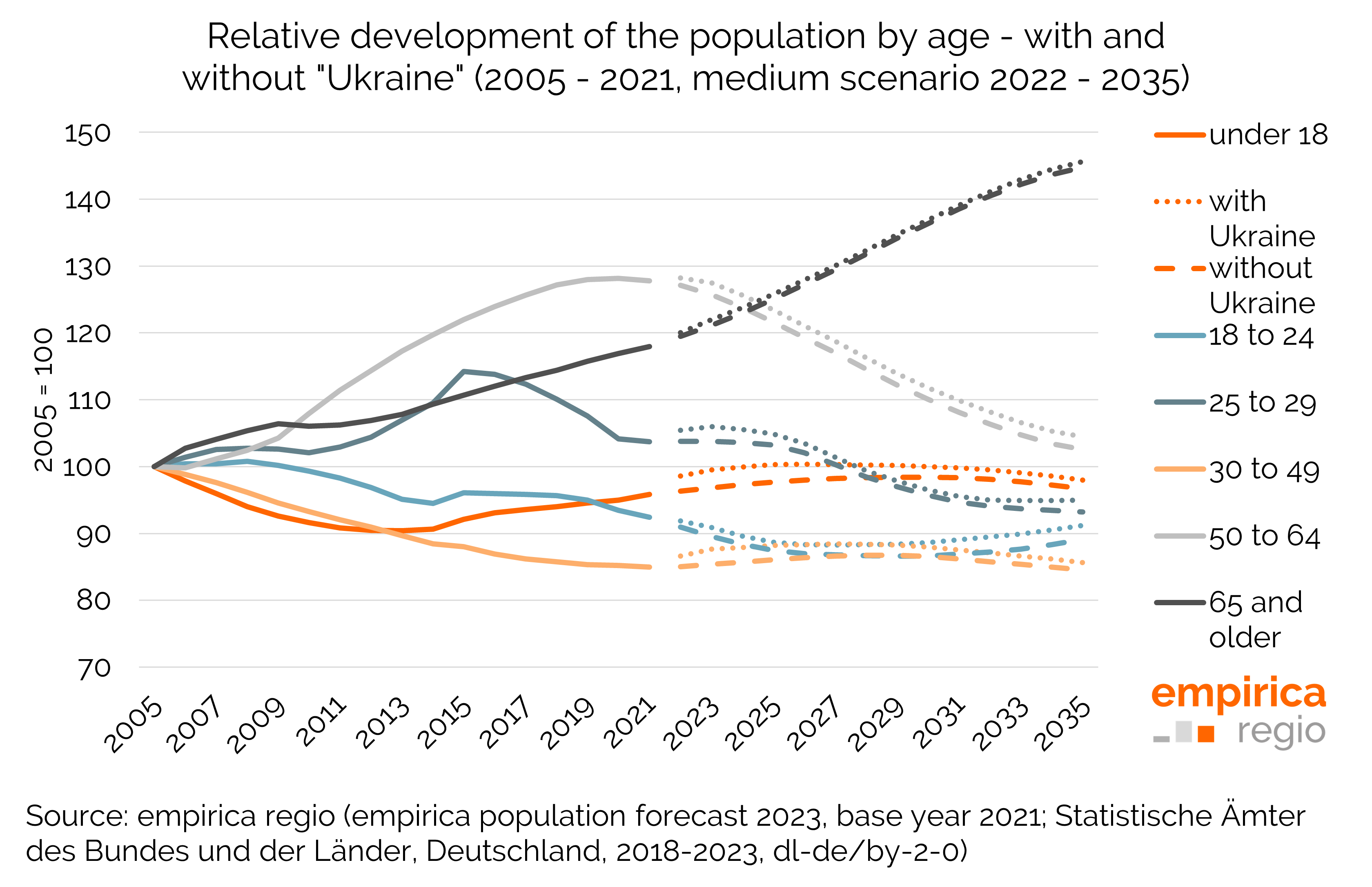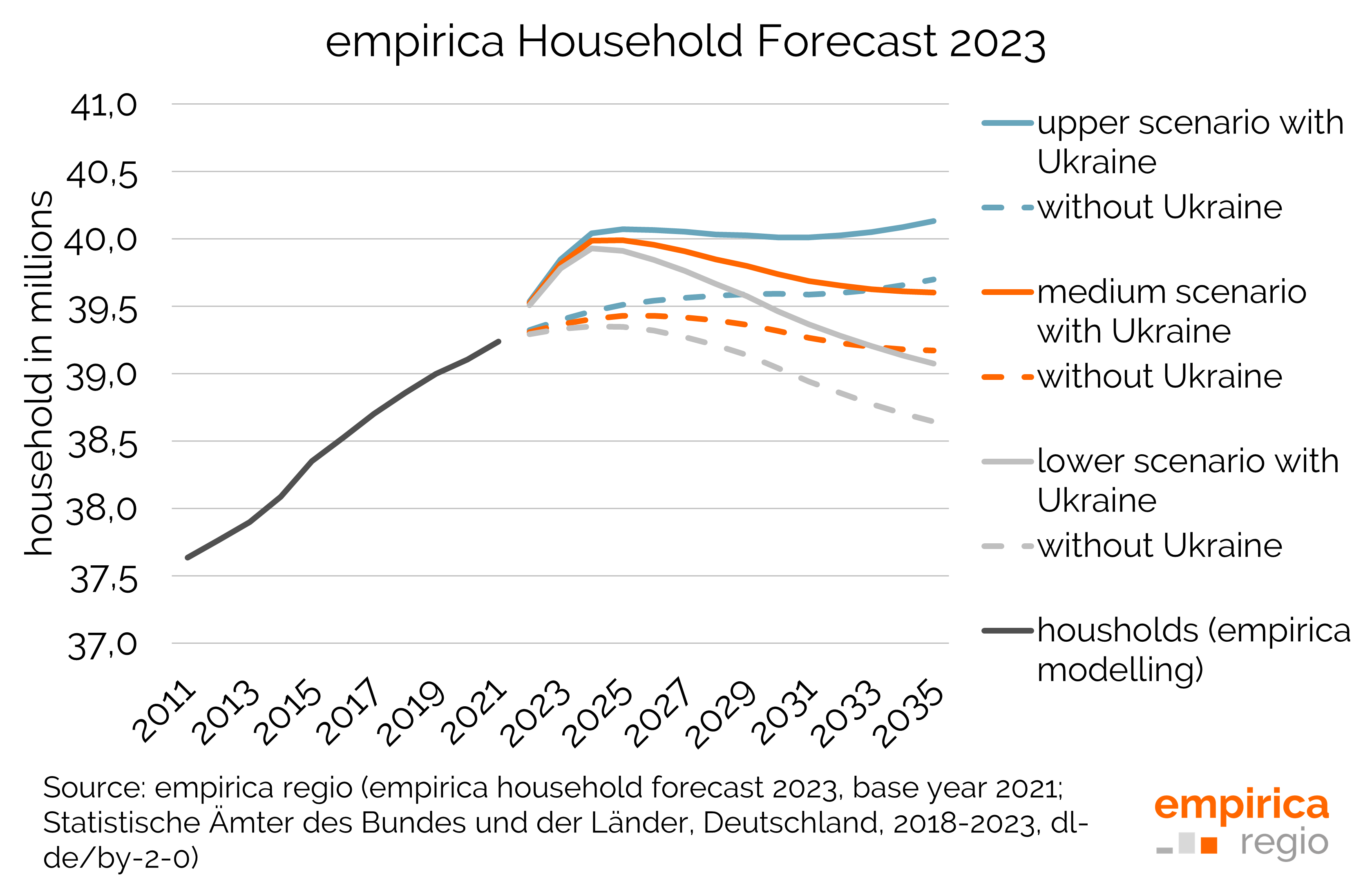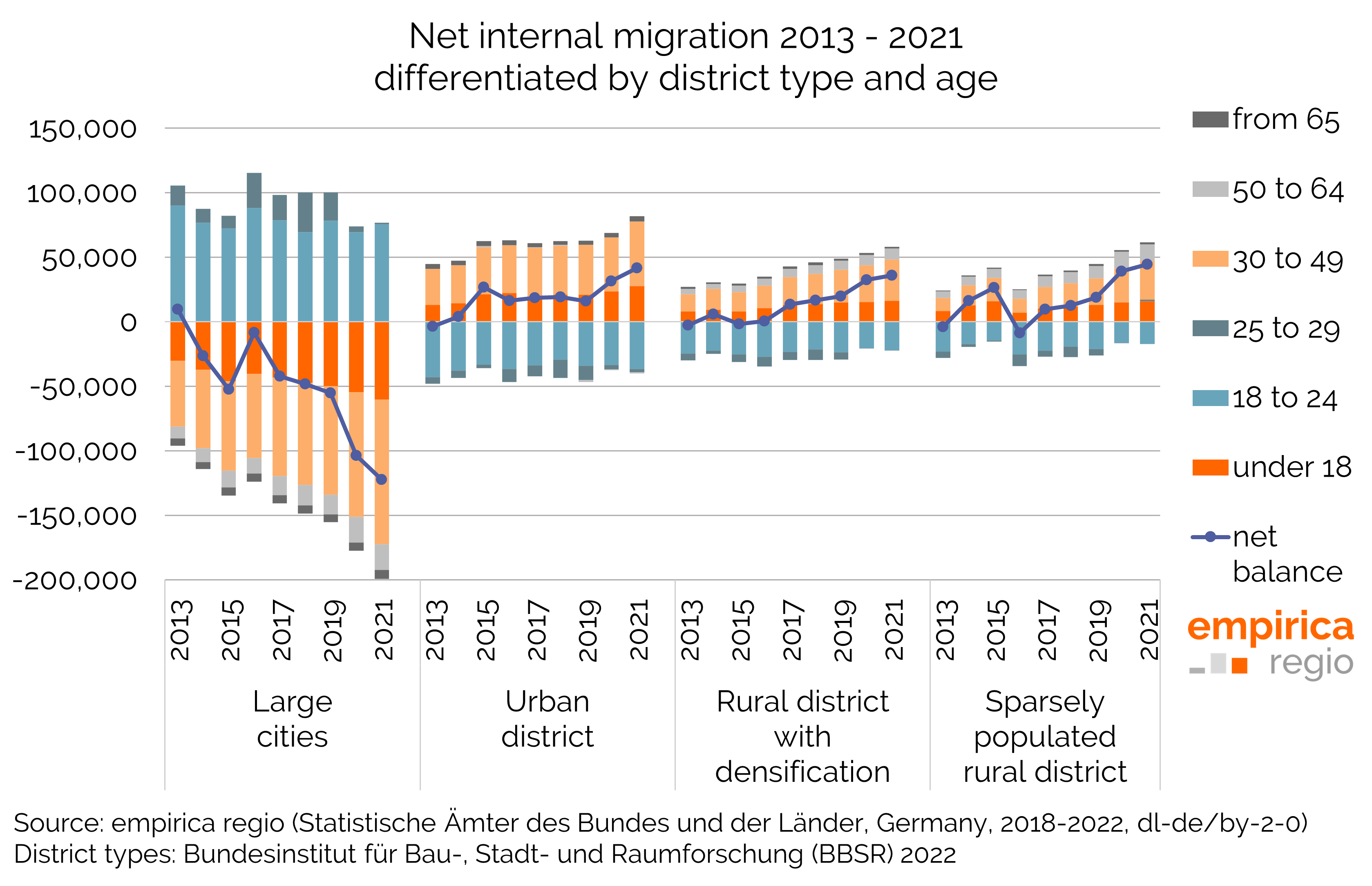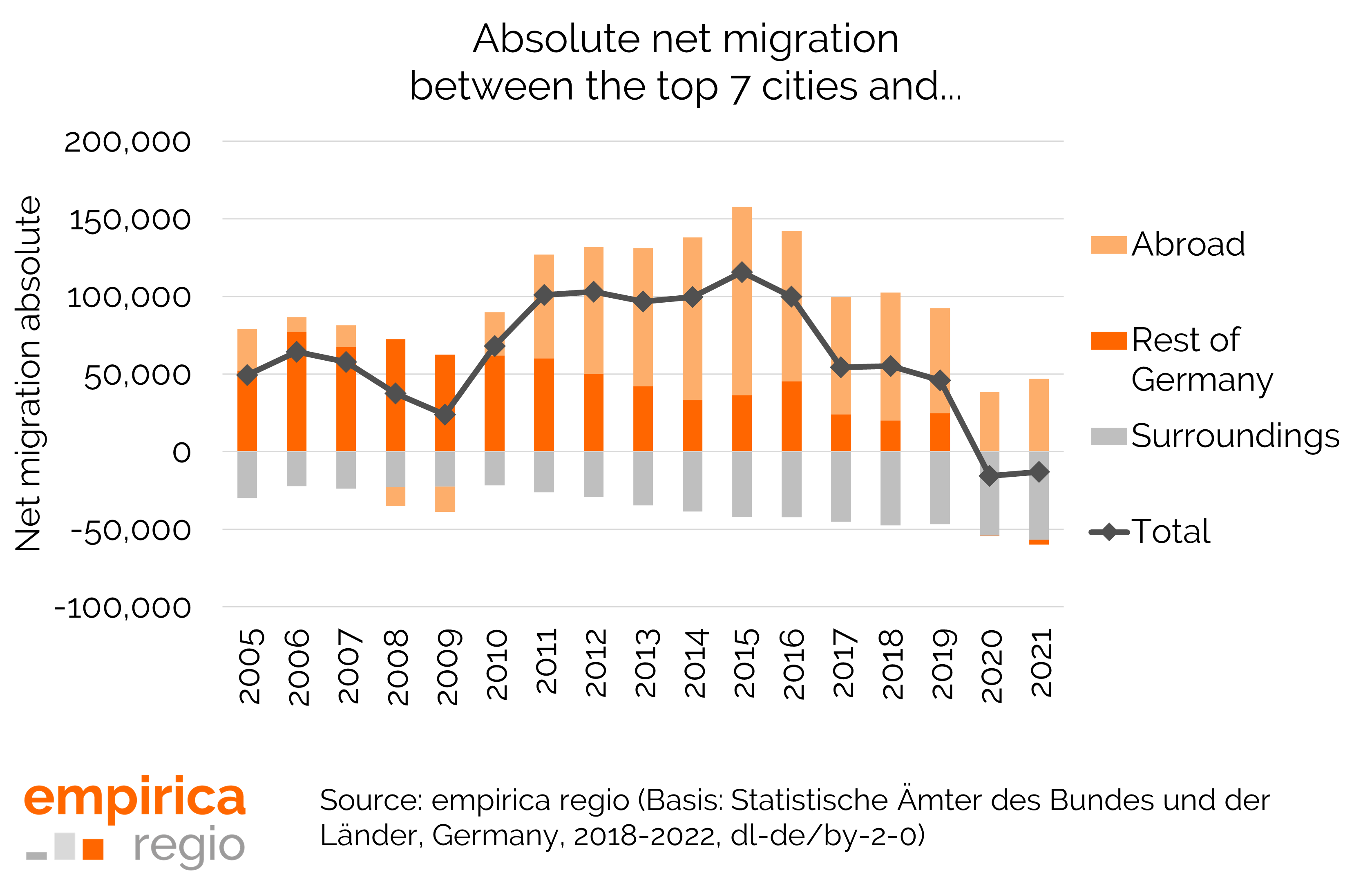Refugees from Ukraine: up to 600,000 additional households on the German housing market
- Around 1.1 million people with Ukrainian citizenship were living in Germany at the end of September.
- Highest immigration rates in March, April and May with up to 375,000 people per month.
- Mostly underage and well-educated people come.
By the end of 2023, there will be up to 600,000 additional households in Germany in demand for housing compared to the end of 2021. This is shown by calculations of the economic and real estate data provider empirica regio. One of the main reasons for this is that the first half of 2022 was the half-year with the largest net immigration to Germany since the reunification. According to figures from the Federal Statistical Office, around 1.05 million people with foreign citizenship came to Germany on balance during this period. For comparison: in the second half of 2015, when the large movement of refugees from Syria began, the net immigration of 756,000 people was significantly lower than this year.
The main reason for the strong immigration is the war in Ukraine. While around 155,000 Ukrainians were registered in Germany at the end of 2021, according to the Central Register of Foreigners, around 1.1 million people with Ukrainian citizenship were living in Germany in September 2022. The rate of immigration was highest in March, April and May, with up to 375,000 people per month.
“The Russian war of aggression on Ukraine has triggered a massive refugee movement of Ukrainians first to neighbouring states, but then also to other states in Europe,” explains Jan Grade, Managing Director of empirica regio. “As a result, the population living in Germany jumped in the very short term. Even though immigration has recently slowed down again somewhat, we currently assume that the peak will not be reached until the end of 2023.”
Refugees are young and well-educated and spread across the country
In particular, the share of minors with Ukrainian citizenship has increased significantly since the beginning of the war. While the under-15s made up only eight per cent of Ukrainians in Germany in February 2022, they already accounted for around 27 per cent in September. According to a joint study by the Federal Office for Migration and Refugees, the Federal Institute for Population Research, the Institute for Employment Research and the Socio-Economic Panel (SOEP) at the German Institute for Economic Research in Berlin, the majority of immigrants also have a high level of education. 72 percent have a university degree or comparable qualifications. Just under one fifth of those surveyed in the study are already employed.
Furthermore, the empirica regio analysis shows that it is not only the cities that benefit from the influx. While people from Ukraine initially settled more in cities such as Berlin and in the eastern German states, the distribution has now aligned with the distribution of the population in Germany. However, many Ukrainian households do not yet live in their own homes.
Relative to the population, a particularly large number of Ukrainian citizens have so far been registered in the cities of Baden-Baden, Hof, Schwerin, Gera, Chemnitz, Bremerhaven and Halle (Saale). Here, the population could be between 3.5 and 4.5 percent higher by the end of 2023 due to the influx of refugees alone than it would have been without the Ukraine war.
“The integration of refugees is a challenge for society as a whole that should not be underestimated: administrations at all levels, non-profit organisations and volunteers must work closely together to ensure primary care and accommodation, the creation of school places for children, language courses and integration into the labour market,” says Grade.
Significantly higher demand for affordable housing
Based on the estimated number of Ukrainians in Germany, empirica regio can also estimate the number of additional households potentially in demand for housing. An initial analysis by empirica showed a range of 120,000 to 500,000 households at the beginning of 2022 with 300,000 to 800,000 refugees from Ukraine. The scenario now drawn up results in a higher number of 600,000 additional households in Germany by the end of 2023. While so far mainly women and children as well as older people have come to Germany, it can be assumed that in the coming years there will be an increased influx of men and households will reunite. Therefore, the average Ukrainian household size of 2.58 persons per household is taken into account in the forecast model.
“The need for new and affordable housing has never been greater,” says Jan Grade. “Nevertheless, housing construction is already lagging far behind demand. Of the 400,000 flats targeted by the federal government, only just under 294,000 could be newly built in 2021. Moreover, the flats have to be built in the right places.”
Forecast: Up to 1.7 million people from Ukraine in Germany by the end of 2023
The empirica regio model assumes a maximum of 1.7 million Ukrainian citizens in Germany in December 2023 - and around 1.2 million in 2030. However, migration movements depend on how the war and the situation in Ukraine develop. Whether people will stay, move on or return to their home country after the war cannot be predicted at this point in time. The forecast therefore represents a possible scenario and the framework conditions can change at any time.
“Even though immigration from Ukraine has recently slowed down somewhat - due to the targeted destruction of the energy infrastructure and the winter that is now setting in, we expect the number of immigrants to rise again in the coming months to up to 80,000 people per month,” Grade explains. “For the summer of 2023, we expect immigration to slow down again and to balance out from autumn 2023. It is expected that the majority of Ukrainians will return to Ukraine from 2024 onwards, so that the total number of Ukrainian nationals living in Germany will slowly decrease.”
Data basis
Jan Grade (2023): empirica Bevölkerungsprognose 2023. Regionalisierte Prognose in drei Varianten bis 2035 und Zusatzprognose der Geflüchteten aus der Ukraine.
Download (external): empirica-Paper Nr. 270.
Dr. Reiner Brau, Jan Grade (2023): Wohnungsmarktprognose 2023. Regionalisierte Prognose in drei Varianten mit Ausblick bis 2035.
Download (external): empirica-Paper Nr. 271





